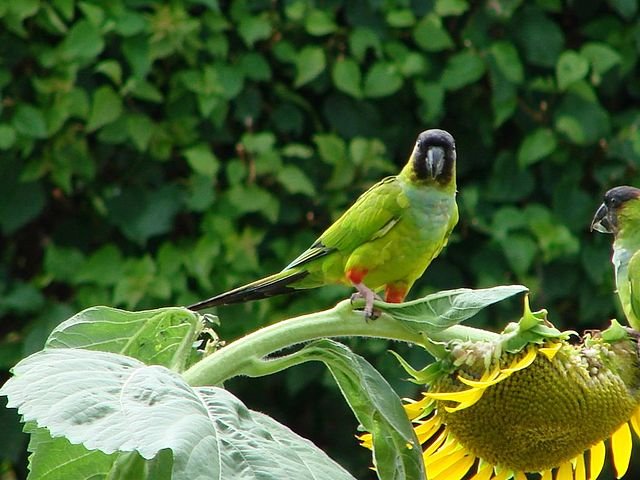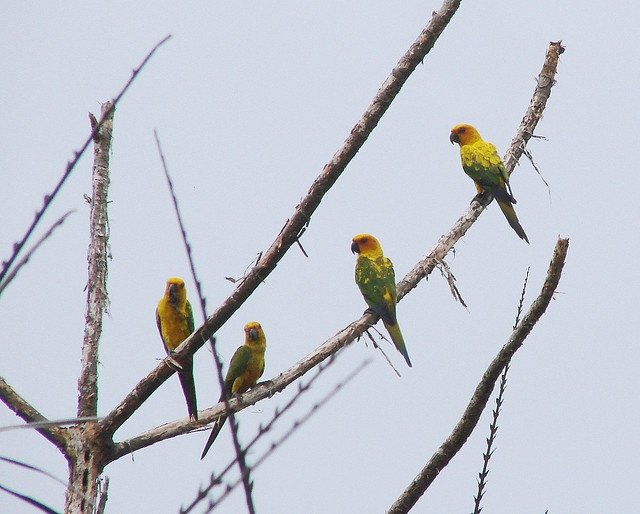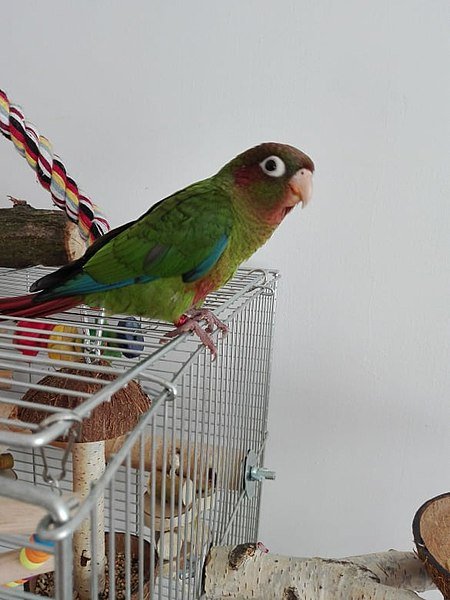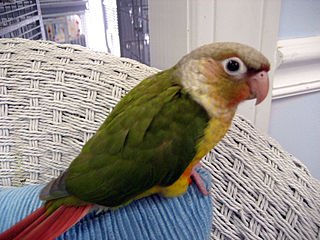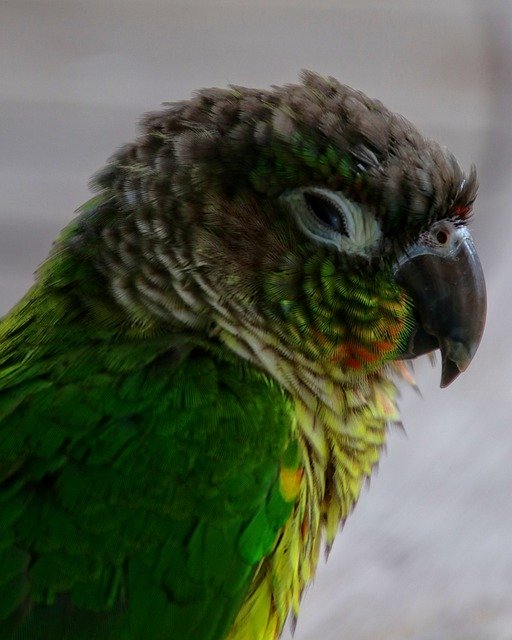For wildlife lovers, conures are a well-known name in the parrot world. Ask them about one, they’ll brief a few of them. But there aren’t just a bunch of few that make up a conure family. There are around a whopping 40 types of conures that makes the conure family one of the most loved in the parrot world. Let’s know all about the conures.
All the different types of conures are divided into a few genera, of which just around a dozen are popularly petted. Let’s get down to each of their genera and the quick detail of the popular ones from each genus.
Aratinga Conures
This genus has around 6 different species and many subspecies of conures. The genus is widely spread across Central and South America, Central Argentina, Mexico, and West Indies. The Aratinga Conure species dwell in all kinds of habitat like savannahs, tropical rainforests, deserts, mountains, and sea. But of the 25 species, only a few are petted like:
Sun Conure
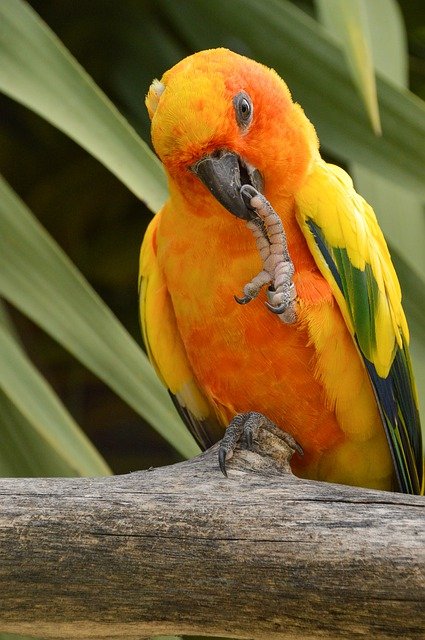
The most loved conure of the Aratinga genus, the sun conure or the sun parakeet is a 12 inches long vividly colored conure that has a rich yellow strikingly distinguishable plumage. The bright orange on the face and belly and green wings make them look like a color palette. Primarily inhabiting the South American regions, they are a favorite among breeders across the globe now. Breeders generally call them Yellow-factor sun conures, since there is a Red-factor sun conure.
They are the most petted Aratinga conure, courtesy of their comical nature and ease to train. Their curious nature makes them learn everything quickly. That said, they might seem the noisiest bird out there for a beginner or an apartment dweller. The shrill in their voice could be a problem for many new conure owners.
Jenday Conure
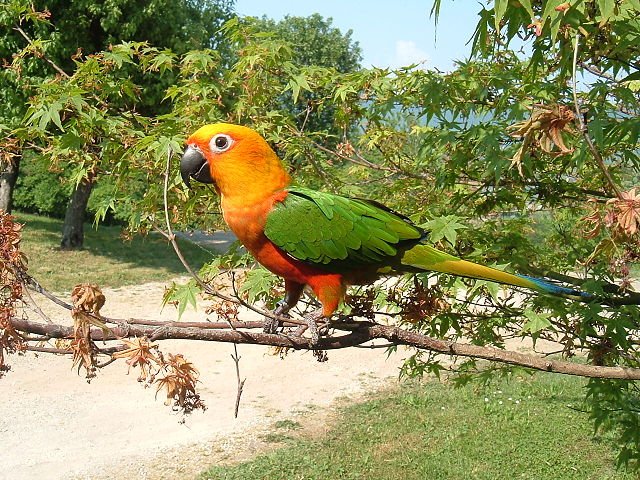
Next in the popularity chart is the Jenday Conure, also known as Jandaya Parakeet. Measuring 12 inches from head to tail, they are still believed to be a subspecies of sun conure by many owing to the similar colors and markings.
Primarily inhabiting the woodlands of many regions of Brazil, they are rarely found in the wild but widely available with the breeders. They are also known as yellow-headed conure in the pet trade.
Nanday Conure
Native to varied regions of South America, the Nanday Conure is the closest cousin of the sun conure. Measuring around 12 inches, they are likened by many pet lovers for their unique color markings. The black face mask and beak and a bluish-green collar on the paper-chest on the otherwise light green plumage matches with no other parrot species. There have been many known hybrids too, with sun conures and jenday, and blue-crowned conures.
Sulphur-breasted Conure
Long regarded invalid as an independent species, the sulphur-breasted parakeet was thought to be a subspecies or hybrids of sun conure only. Measuring around 11.7 inches, sulphur-breasted have generally green suffusion to their yellow plumage on the mantle, underparts, and underwings. Inhabiting the regions near the Amazon River in Brazil and savannahs of Suriname, their regions also overlap with sun conures.
Blue-crowned Conure
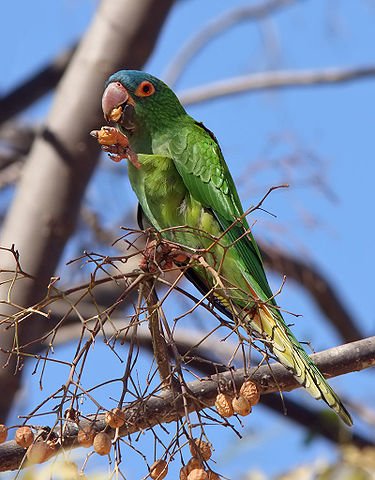
Falling in the further classified genus Thectocercus, the blue-crowned conure is the only species of the mini genus inside the main Aratinga Genus. Measuring around 14.5 inches in length, these birds have predominantly green plumage with a blue crown, forehead, ears, and cheeks. At times, the breast feathers can have a little blue tinge. Native to South America, these birds are quite famed pets owing to their ease of care and talking prowess.
Other Aratinga Conures
Apart from the above-mentioned famous Aratinga species, there are conures like Golden-capped Parakeet, Dusky-headed Conure, and the now-extinct Aratinga Vorohuensis.
Pyrrhura Conures
This genus encompasses around 22 species and many subspecies. The species in this genus is relatively smaller in size than their cousins in the Aratinga genus. The smallest conure, i.e. the Painted Conure belongs to this genus only. Another distinguishable feature of the species of this genus is their noise level. They are the quieter genus against the infamously loud Aratinga genus. The genus has some of the most famous pet species:
Green-cheek Conure
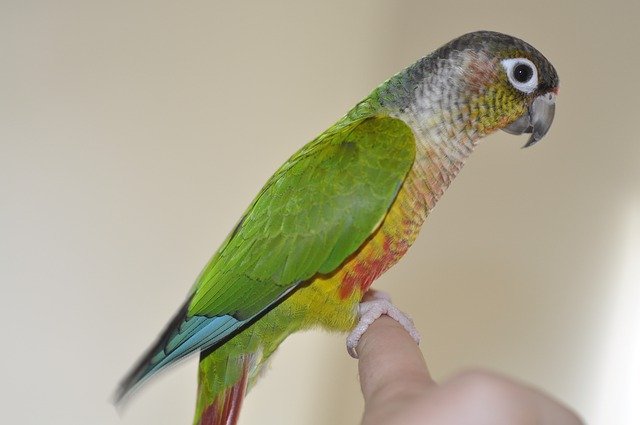
Native to the forests and woodlands of South America, the green-cheek conure is the most famous and loved species, especially among apartment dwellers. Measuring around 10 inches from head to tail, they primarily have an overall green plumage. The primary wing feathers are blue and the tail is red. With five subspecies and many famous color mutations like Cinnamon and Pineapple conure, they offer a long list of alternatives to choose from companion birds.
Green cheek conure’s quiet nature and mischievous personality have made him a loved pet across the world. Living for around 30 years in captivity, green cheeks have an edge over almost all other conure species to retain their status of most loved conure.
Maroon-bellied Conure
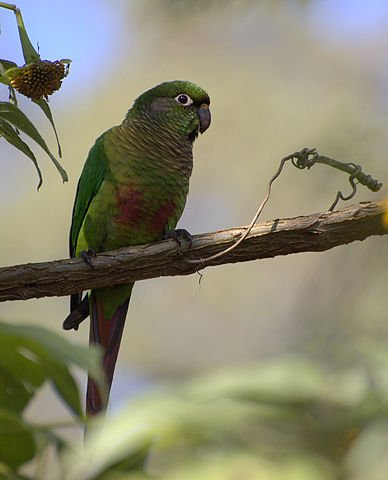
Native to the forest edges and woodlands of Brazil and Argentina, a maroon-bellied conure is a small species measuring just around 10-11 inches. Covered in a green plumage, they have a distinctive maroon patch on their bellies. The breast and neck are scaly with yellow-green markings. The off-white on ears washed with brown has earned them another name of Brown-eared Conure. Though not petted as extensively as other conures, they can still be found easily with the breeders.
Black-capped Conure

Also known as the Rock Conure, the black-capped conures are native to the Amazon Basin and the nearby regions of Bolivia, Brazil, and Peru. With shrinking Amazons, they have been declared ‘near threatened’ species. They are mostly dark green with white scallops on the breast and hindneck. The head color justifies their name. They are popular pets owing to their small size (10 inches), social behavior, and quiet demeanor.
Crimson-bellied Conure
Native to the Amazon rainforests of Bolivia and Brazil, the crimson-bellied conures have a special liking to the dense forests. Not petted very extensively, they are still preferred by many looking for a vividly colored parrot matched with a lively personality. Measuring just around 9 inches, they have a large personality in small bodies. They easily manage to learn quite a few words and are good companions even for apartment dwellers. Identifying them with their silverish-blue collar at the hindneck along with that crimson-colored belly is the easiest way of marking them.
Blaze-winged Conure
Native to the woodlands of Bolivia, Brazil, and Paraguay, blaze-winged conures have been declared as ‘near threatened’ due to extreme loss of their habitat. Often thought to be the subspecies of a maroon-bellied conure, they both share some similar colors and markings. But the dusky crown and blaze-like red on the shoulders make them stand out. They are rarely kept as pets.
Rose-crowned Conure
Native to the tropical and subtropical moist forests of Venezuela, rose-crowned conure is a small-sized parrot covered in a green plumage. To distinguish the species from the swarm of other South American species, look for the red cap and white primary wing coverts. The species have been declared uncommon in captivity.
Other Pyrrhura Conures
Apart from these famous conure species, there a few other species and subspecies that belong to the genus like Pearly Conure, Painted Conure, Emma’s Conure, Rose-fronted Conure, Grey-breasted Parakeet, White-eared Parakeet, Fiery-shouldered Conure, Pfrimer’s Conure, Red-eared Conure, El Oro Parakeet, Hoffmann’s Conure, et al.
Psittacara Conures
Previously thought to be from the Aratinga genus, there are around 14 species that have later been classified under this separate genus.
Cherry-headed Conure
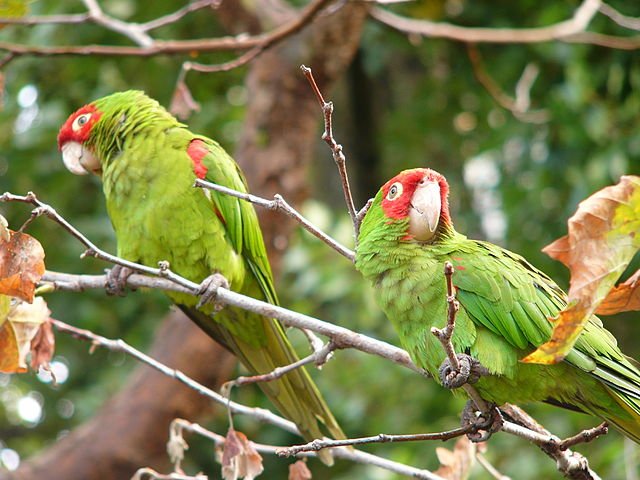
The best talker in the conure family, cherry-headed are famed as red-masked conures in aviculture. Measuring around 13 inches, half of their length is their long tail. Primarily covered in a bright green plumage with a noticeably red or cherry-colored head. There is some red on the edges of the wings, neck, and thighs. Inhabiting the deciduous forests of Ecuador and Peru, they have adapted well to the city lives over time.
The species is considered to be quite loud and screamy for their intermittent noises. They aren’t the talkers of the conure family and can hardly say a word or two. However, they are petted across the globe for their playful and fun-loving personality.
Mitred Conure
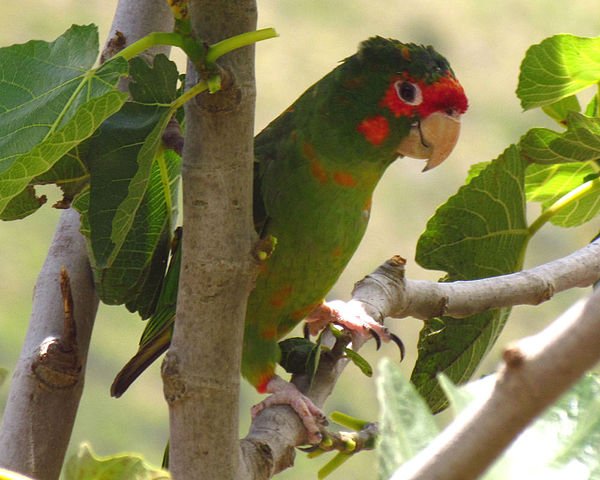
The mitred conure or mitred parakeet is a red-green parrot that averages around 14 inches. With an overall green plumage, the conure has the most distinct red sprinkled on and around the face and thighs. They dwell at some of the highest altitudes in the woodlands and both deciduous and humid forest areas of Peru, Bolivia, and Argentina.
Quite a social species, mitred conures are adopted for their comical behavior and ability to grasp quite a few words. Though they aren’t great birds for beginners or apartment dwellers for their loud behavior, they have earned the status of a watchdog aka watch-bird for their ability to raise the highest alarms on seeing strangers near the house.
Scarlet-fronted Conure
Also known as the red-fronted conure or the Wagler’s Conure, they are long-tailed parrots native to the South American subtropical and tropical regions. Primarily brighter green, they have a red plumage on the top of the head that extends behind the eyes. There may be red sprinkled on the throat and wings. The thighs are also red. They are rarely captivated.
Other Psittacara Conures
There are many other species like Pacific Conure, Cuban Conure, Finsch’s Conure, Nicaraguan green Conure, red-throated Conure, et al but they aren’t kept widely as pets.
Leptosittaca Conure
This genus has just one species called Golden-plumed Conure. Similar to the Aratinga genus species, these conures love to dwell in the temperate highlands, cloud forests, and temperate regions. Native to Peru, Colombia, and Ecuador, these conures are greatly threatened due to the loss of their natural habitat. They are rarely kept as pets due to their smaller numbers. Interestingly, they possess a unique ability to detect ultraviolet radiation.
Cyanoliseus Conure
Another monotypic genus, it has just one species called Patagonian Conure. Also known as Burrowing Parrot, they are loved as pets for their mimicking abilities. Another reason for their fame as a good companion bird is that they become family pets rather than becoming single-person pets. With around four subspecies, there is a good list to choose from.
Enicognathus Conures
The genus has two species along with a few subspecies. The two species are Austral Conures and the Slender-billed Conures. Both of the species and their subspecies are rarely kept as pets.
Guarouba Conures
A monotypic genus, the beautiful Golden Conure falls in this genus. Known as Queen of Bavaria, the bird is covered mostly in a bright yellow plumage with just a little green at the tips of the wing feathers. Native to the rainforests of the Amazon Basin, the golden conure is now a threatened species due to shrinking habitat and illegal trading for decades. That said, they are still captivated by a few for their mesmerizing plumage. Not much is documented about their life in the wild.
Ognorhynchus Conures
Another monotypic genus, there is just a yellow-eared conure that forms this genus. Thought to be extinct until two decades ago, the yellow-eared was declared still surviving when 81 birds were found in the Colombian Andes. They are fairly large conures measuring around 17 inches from head to tail, and have an overall green plumage with yellow splashed on the forehead, cheeks, and ear coverts. Once petted for their social nature, they are hardly bred and petted for their low numbers.
Summing Up
Infamous as loud and nippy, conures are just not all about it. Where it is true with the Aratinga genus, it hardly applies to the species of the Pyrrhura genus. And then there are a few other genera too. If the choice has to be made from the conure family, there is something for everyone. The quiet ones aka the green-cheek conures; the mimicking genius aka Patagonian Conure; the best talker aka the Blue-Crowned conure; one can choose from an array of species matched with their preferences.

